Data Analytics Report: Analysis of the Startup Muster Annual Report
VerifiedAdded on 2022/09/16
|10
|2124
|12
Report
AI Summary
This report provides a comprehensive data analytics analysis of the Startup Muster annual report, focusing on the Australian startup ecosystem. The analysis is divided into two parts. Part A examines the Startup Muster report, highlighting key insights such as the importance of commercialization, export, and growth of startups, and critiques the report's presentation methods, including the use of graphs and charts. The report also discusses the metrics used, such as the number of new startups launched, and suggests improvements. Part B summarizes a guest speaker's insights on business analytics, emphasizing the role of data in making investment and strategic decisions, and the importance of data analytics in consulting. The report concludes that big data is essential for strategic and investment decision-making, and that businesses need data to guide their operations, establish trends, and make appropriate decisions. The report provides a critical analysis of the Startup Muster report and the guest speaker's insights, offering a valuable perspective on the application of data analytics in business.
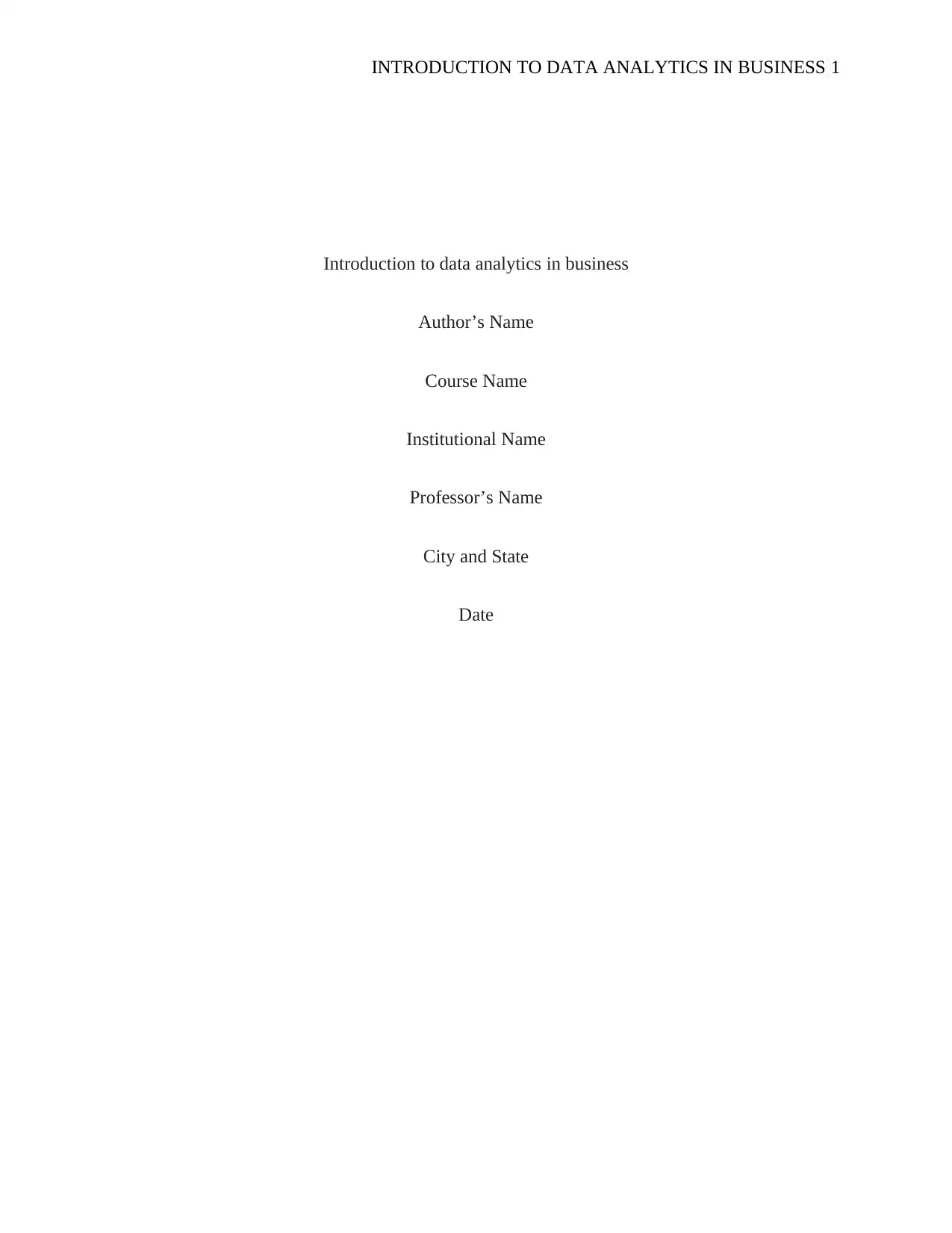
INTRODUCTION TO DATA ANALYTICS IN BUSINESS 1
Introduction to data analytics in business
Author’s Name
Course Name
Institutional Name
Professor’s Name
City and State
Date
Introduction to data analytics in business
Author’s Name
Course Name
Institutional Name
Professor’s Name
City and State
Date
Paraphrase This Document
Need a fresh take? Get an instant paraphrase of this document with our AI Paraphraser
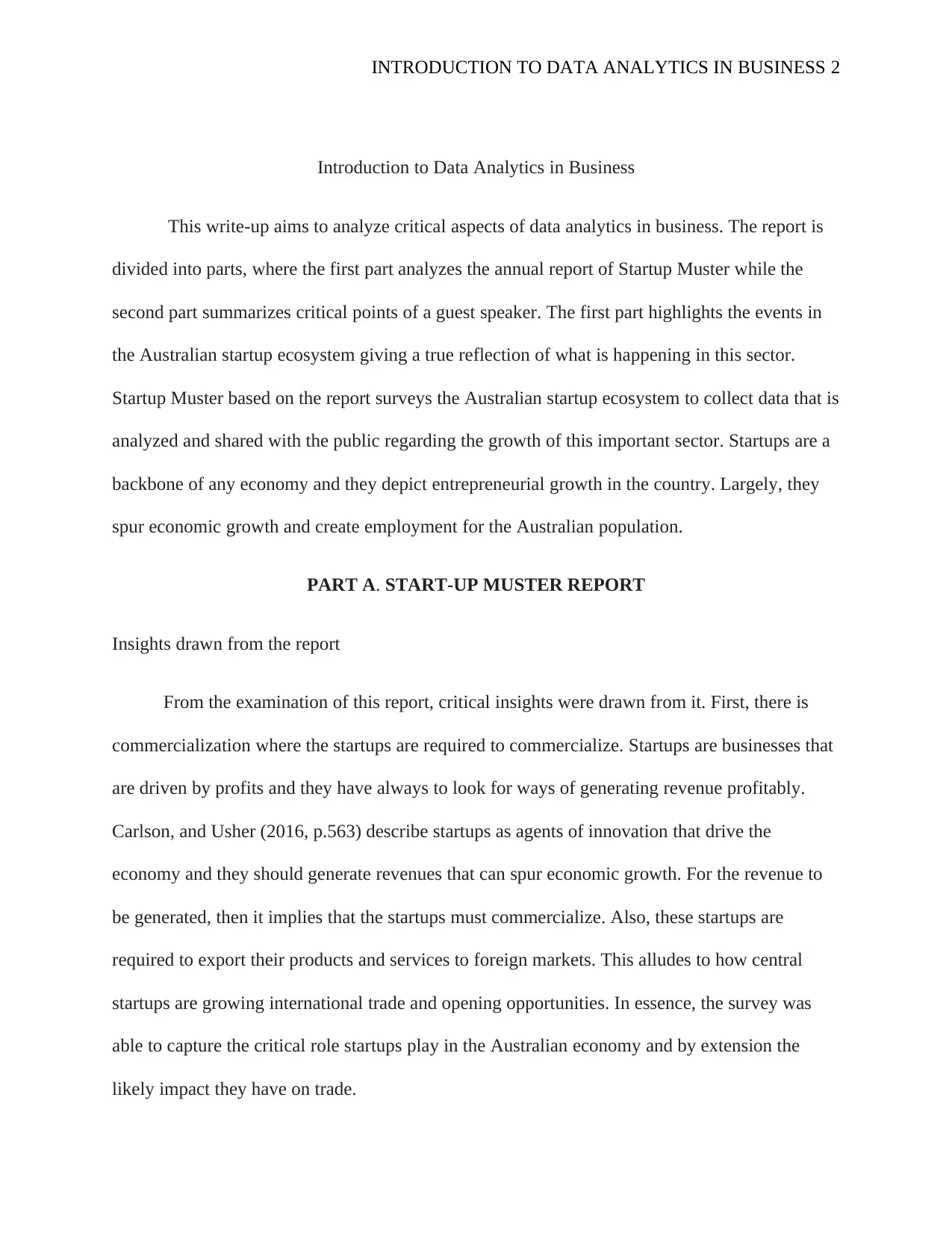
INTRODUCTION TO DATA ANALYTICS IN BUSINESS 2
Introduction to Data Analytics in Business
This write-up aims to analyze critical aspects of data analytics in business. The report is
divided into parts, where the first part analyzes the annual report of Startup Muster while the
second part summarizes critical points of a guest speaker. The first part highlights the events in
the Australian startup ecosystem giving a true reflection of what is happening in this sector.
Startup Muster based on the report surveys the Australian startup ecosystem to collect data that is
analyzed and shared with the public regarding the growth of this important sector. Startups are a
backbone of any economy and they depict entrepreneurial growth in the country. Largely, they
spur economic growth and create employment for the Australian population.
PART A. START-UP MUSTER REPORT
Insights drawn from the report
From the examination of this report, critical insights were drawn from it. First, there is
commercialization where the startups are required to commercialize. Startups are businesses that
are driven by profits and they have always to look for ways of generating revenue profitably.
Carlson, and Usher (2016, p.563) describe startups as agents of innovation that drive the
economy and they should generate revenues that can spur economic growth. For the revenue to
be generated, then it implies that the startups must commercialize. Also, these startups are
required to export their products and services to foreign markets. This alludes to how central
startups are growing international trade and opening opportunities. In essence, the survey was
able to capture the critical role startups play in the Australian economy and by extension the
likely impact they have on trade.
Introduction to Data Analytics in Business
This write-up aims to analyze critical aspects of data analytics in business. The report is
divided into parts, where the first part analyzes the annual report of Startup Muster while the
second part summarizes critical points of a guest speaker. The first part highlights the events in
the Australian startup ecosystem giving a true reflection of what is happening in this sector.
Startup Muster based on the report surveys the Australian startup ecosystem to collect data that is
analyzed and shared with the public regarding the growth of this important sector. Startups are a
backbone of any economy and they depict entrepreneurial growth in the country. Largely, they
spur economic growth and create employment for the Australian population.
PART A. START-UP MUSTER REPORT
Insights drawn from the report
From the examination of this report, critical insights were drawn from it. First, there is
commercialization where the startups are required to commercialize. Startups are businesses that
are driven by profits and they have always to look for ways of generating revenue profitably.
Carlson, and Usher (2016, p.563) describe startups as agents of innovation that drive the
economy and they should generate revenues that can spur economic growth. For the revenue to
be generated, then it implies that the startups must commercialize. Also, these startups are
required to export their products and services to foreign markets. This alludes to how central
startups are growing international trade and opening opportunities. In essence, the survey was
able to capture the critical role startups play in the Australian economy and by extension the
likely impact they have on trade.
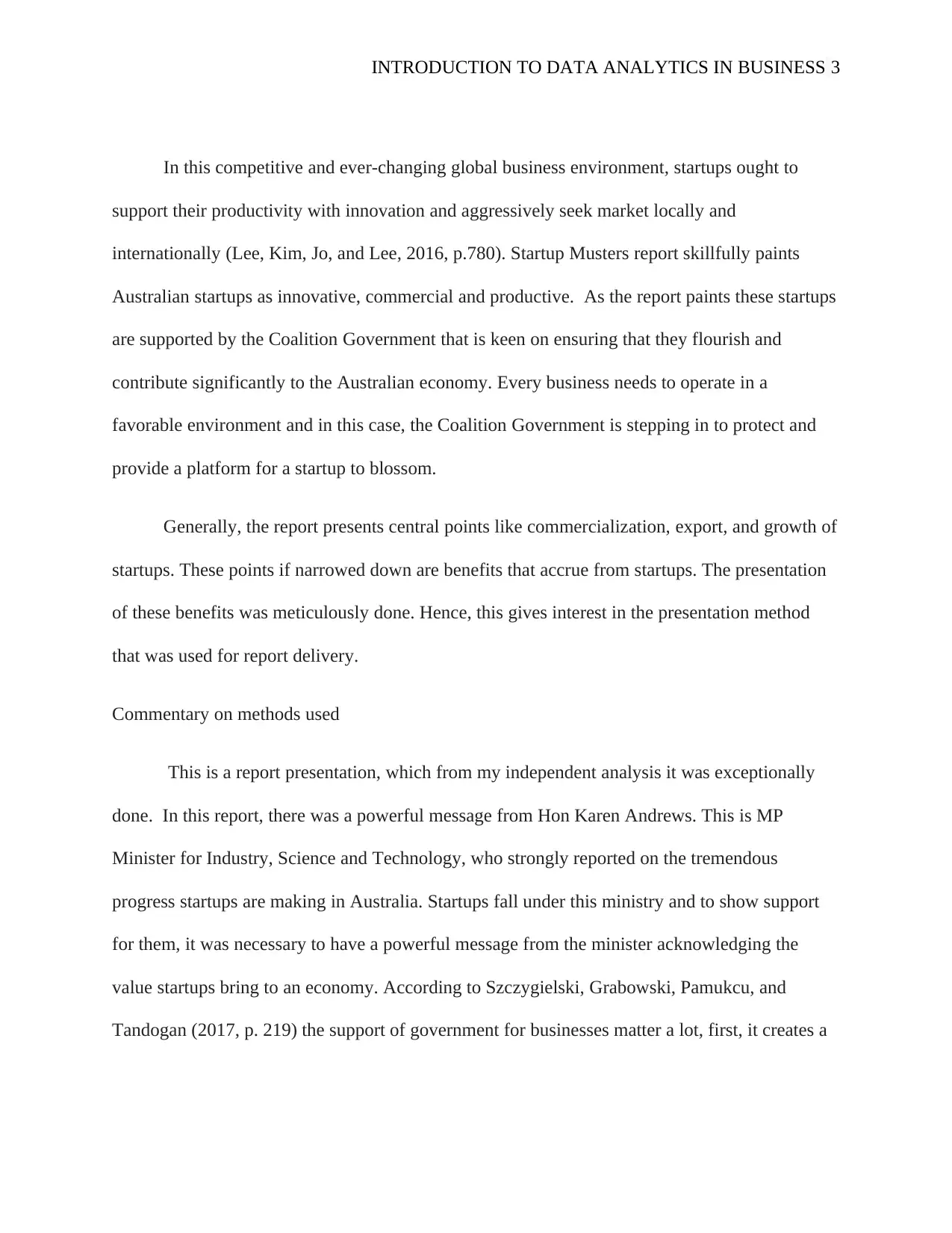
INTRODUCTION TO DATA ANALYTICS IN BUSINESS 3
In this competitive and ever-changing global business environment, startups ought to
support their productivity with innovation and aggressively seek market locally and
internationally (Lee, Kim, Jo, and Lee, 2016, p.780). Startup Musters report skillfully paints
Australian startups as innovative, commercial and productive. As the report paints these startups
are supported by the Coalition Government that is keen on ensuring that they flourish and
contribute significantly to the Australian economy. Every business needs to operate in a
favorable environment and in this case, the Coalition Government is stepping in to protect and
provide a platform for a startup to blossom.
Generally, the report presents central points like commercialization, export, and growth of
startups. These points if narrowed down are benefits that accrue from startups. The presentation
of these benefits was meticulously done. Hence, this gives interest in the presentation method
that was used for report delivery.
Commentary on methods used
This is a report presentation, which from my independent analysis it was exceptionally
done. In this report, there was a powerful message from Hon Karen Andrews. This is MP
Minister for Industry, Science and Technology, who strongly reported on the tremendous
progress startups are making in Australia. Startups fall under this ministry and to show support
for them, it was necessary to have a powerful message from the minister acknowledging the
value startups bring to an economy. According to Szczygielski, Grabowski, Pamukcu, and
Tandogan (2017, p. 219) the support of government for businesses matter a lot, first, it creates a
In this competitive and ever-changing global business environment, startups ought to
support their productivity with innovation and aggressively seek market locally and
internationally (Lee, Kim, Jo, and Lee, 2016, p.780). Startup Musters report skillfully paints
Australian startups as innovative, commercial and productive. As the report paints these startups
are supported by the Coalition Government that is keen on ensuring that they flourish and
contribute significantly to the Australian economy. Every business needs to operate in a
favorable environment and in this case, the Coalition Government is stepping in to protect and
provide a platform for a startup to blossom.
Generally, the report presents central points like commercialization, export, and growth of
startups. These points if narrowed down are benefits that accrue from startups. The presentation
of these benefits was meticulously done. Hence, this gives interest in the presentation method
that was used for report delivery.
Commentary on methods used
This is a report presentation, which from my independent analysis it was exceptionally
done. In this report, there was a powerful message from Hon Karen Andrews. This is MP
Minister for Industry, Science and Technology, who strongly reported on the tremendous
progress startups are making in Australia. Startups fall under this ministry and to show support
for them, it was necessary to have a powerful message from the minister acknowledging the
value startups bring to an economy. According to Szczygielski, Grabowski, Pamukcu, and
Tandogan (2017, p. 219) the support of government for businesses matter a lot, first, it creates a
⊘ This is a preview!⊘
Do you want full access?
Subscribe today to unlock all pages.

Trusted by 1+ million students worldwide
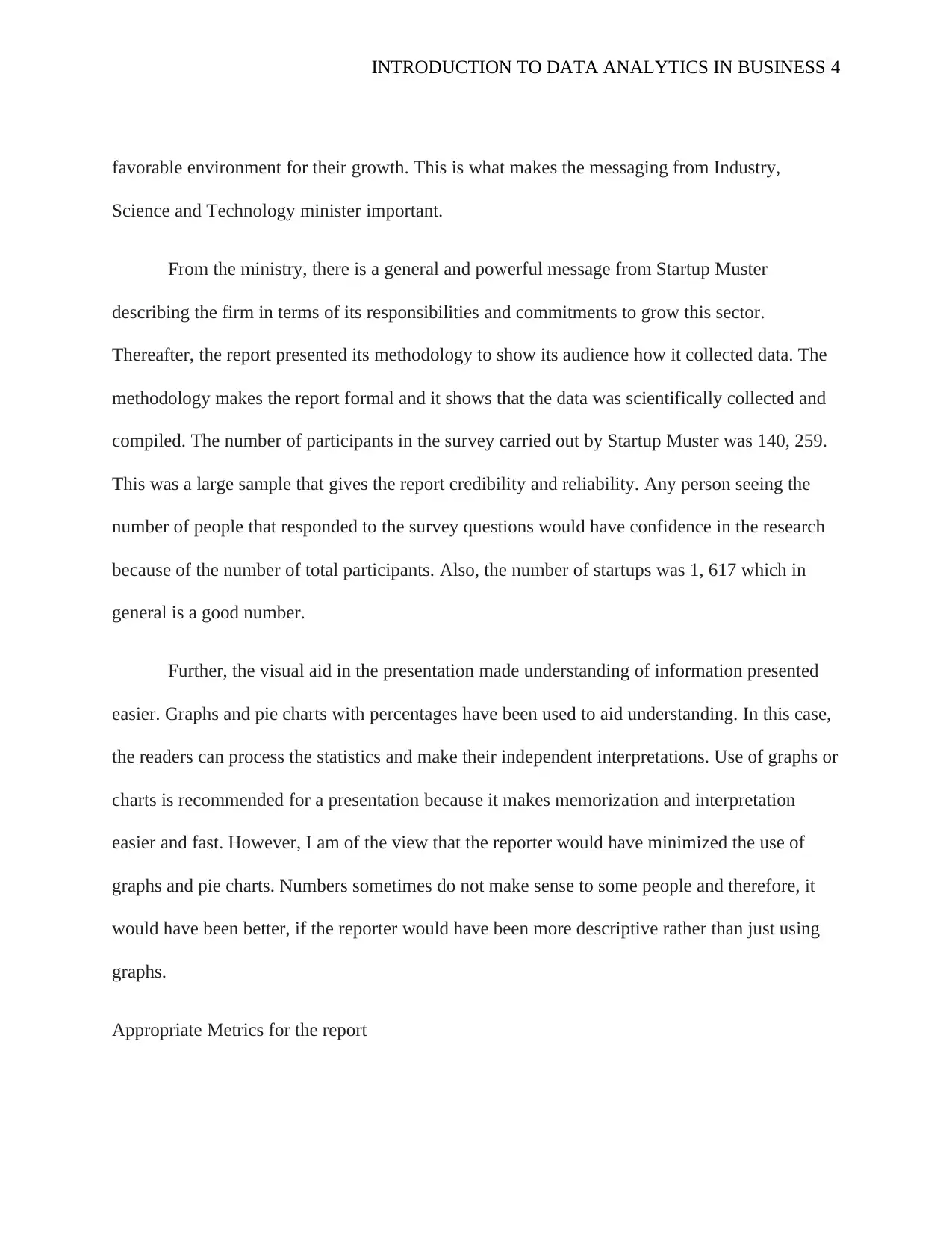
INTRODUCTION TO DATA ANALYTICS IN BUSINESS 4
favorable environment for their growth. This is what makes the messaging from Industry,
Science and Technology minister important.
From the ministry, there is a general and powerful message from Startup Muster
describing the firm in terms of its responsibilities and commitments to grow this sector.
Thereafter, the report presented its methodology to show its audience how it collected data. The
methodology makes the report formal and it shows that the data was scientifically collected and
compiled. The number of participants in the survey carried out by Startup Muster was 140, 259.
This was a large sample that gives the report credibility and reliability. Any person seeing the
number of people that responded to the survey questions would have confidence in the research
because of the number of total participants. Also, the number of startups was 1, 617 which in
general is a good number.
Further, the visual aid in the presentation made understanding of information presented
easier. Graphs and pie charts with percentages have been used to aid understanding. In this case,
the readers can process the statistics and make their independent interpretations. Use of graphs or
charts is recommended for a presentation because it makes memorization and interpretation
easier and fast. However, I am of the view that the reporter would have minimized the use of
graphs and pie charts. Numbers sometimes do not make sense to some people and therefore, it
would have been better, if the reporter would have been more descriptive rather than just using
graphs.
Appropriate Metrics for the report
favorable environment for their growth. This is what makes the messaging from Industry,
Science and Technology minister important.
From the ministry, there is a general and powerful message from Startup Muster
describing the firm in terms of its responsibilities and commitments to grow this sector.
Thereafter, the report presented its methodology to show its audience how it collected data. The
methodology makes the report formal and it shows that the data was scientifically collected and
compiled. The number of participants in the survey carried out by Startup Muster was 140, 259.
This was a large sample that gives the report credibility and reliability. Any person seeing the
number of people that responded to the survey questions would have confidence in the research
because of the number of total participants. Also, the number of startups was 1, 617 which in
general is a good number.
Further, the visual aid in the presentation made understanding of information presented
easier. Graphs and pie charts with percentages have been used to aid understanding. In this case,
the readers can process the statistics and make their independent interpretations. Use of graphs or
charts is recommended for a presentation because it makes memorization and interpretation
easier and fast. However, I am of the view that the reporter would have minimized the use of
graphs and pie charts. Numbers sometimes do not make sense to some people and therefore, it
would have been better, if the reporter would have been more descriptive rather than just using
graphs.
Appropriate Metrics for the report
Paraphrase This Document
Need a fresh take? Get an instant paraphrase of this document with our AI Paraphraser
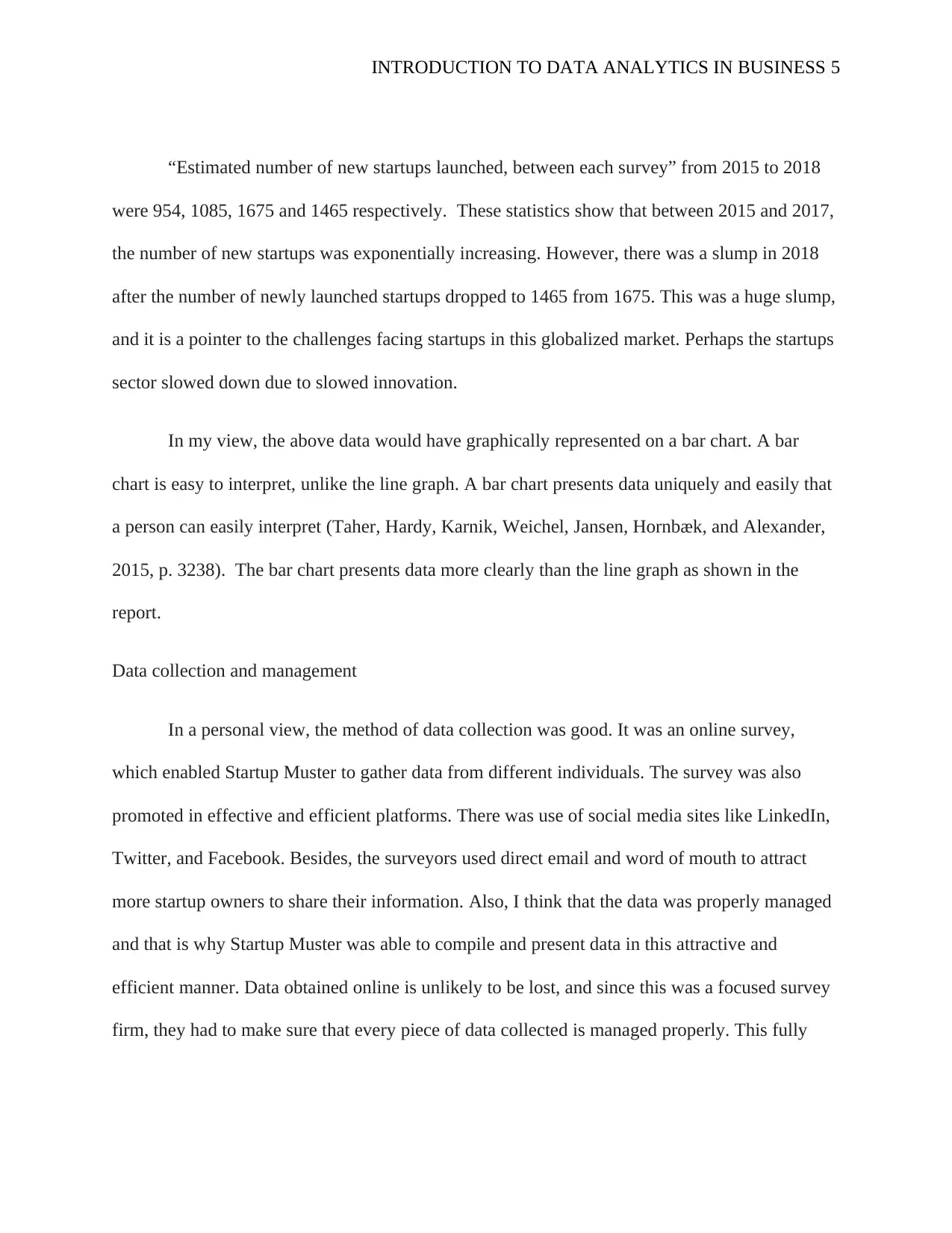
INTRODUCTION TO DATA ANALYTICS IN BUSINESS 5
“Estimated number of new startups launched, between each survey” from 2015 to 2018
were 954, 1085, 1675 and 1465 respectively. These statistics show that between 2015 and 2017,
the number of new startups was exponentially increasing. However, there was a slump in 2018
after the number of newly launched startups dropped to 1465 from 1675. This was a huge slump,
and it is a pointer to the challenges facing startups in this globalized market. Perhaps the startups
sector slowed down due to slowed innovation.
In my view, the above data would have graphically represented on a bar chart. A bar
chart is easy to interpret, unlike the line graph. A bar chart presents data uniquely and easily that
a person can easily interpret (Taher, Hardy, Karnik, Weichel, Jansen, Hornbæk, and Alexander,
2015, p. 3238). The bar chart presents data more clearly than the line graph as shown in the
report.
Data collection and management
In a personal view, the method of data collection was good. It was an online survey,
which enabled Startup Muster to gather data from different individuals. The survey was also
promoted in effective and efficient platforms. There was use of social media sites like LinkedIn,
Twitter, and Facebook. Besides, the surveyors used direct email and word of mouth to attract
more startup owners to share their information. Also, I think that the data was properly managed
and that is why Startup Muster was able to compile and present data in this attractive and
efficient manner. Data obtained online is unlikely to be lost, and since this was a focused survey
firm, they had to make sure that every piece of data collected is managed properly. This fully
“Estimated number of new startups launched, between each survey” from 2015 to 2018
were 954, 1085, 1675 and 1465 respectively. These statistics show that between 2015 and 2017,
the number of new startups was exponentially increasing. However, there was a slump in 2018
after the number of newly launched startups dropped to 1465 from 1675. This was a huge slump,
and it is a pointer to the challenges facing startups in this globalized market. Perhaps the startups
sector slowed down due to slowed innovation.
In my view, the above data would have graphically represented on a bar chart. A bar
chart is easy to interpret, unlike the line graph. A bar chart presents data uniquely and easily that
a person can easily interpret (Taher, Hardy, Karnik, Weichel, Jansen, Hornbæk, and Alexander,
2015, p. 3238). The bar chart presents data more clearly than the line graph as shown in the
report.
Data collection and management
In a personal view, the method of data collection was good. It was an online survey,
which enabled Startup Muster to gather data from different individuals. The survey was also
promoted in effective and efficient platforms. There was use of social media sites like LinkedIn,
Twitter, and Facebook. Besides, the surveyors used direct email and word of mouth to attract
more startup owners to share their information. Also, I think that the data was properly managed
and that is why Startup Muster was able to compile and present data in this attractive and
efficient manner. Data obtained online is unlikely to be lost, and since this was a focused survey
firm, they had to make sure that every piece of data collected is managed properly. This fully
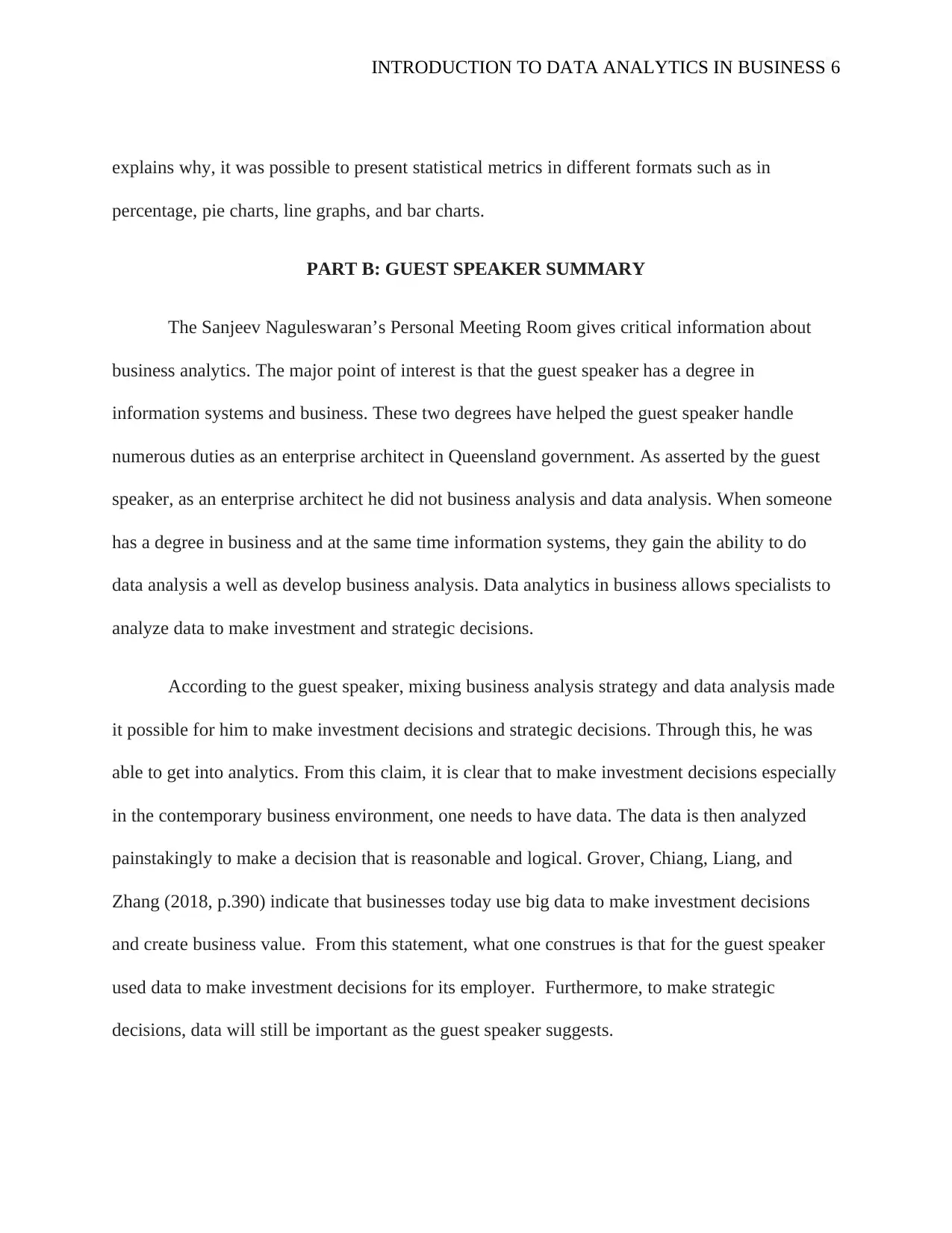
INTRODUCTION TO DATA ANALYTICS IN BUSINESS 6
explains why, it was possible to present statistical metrics in different formats such as in
percentage, pie charts, line graphs, and bar charts.
PART B: GUEST SPEAKER SUMMARY
The Sanjeev Naguleswaran’s Personal Meeting Room gives critical information about
business analytics. The major point of interest is that the guest speaker has a degree in
information systems and business. These two degrees have helped the guest speaker handle
numerous duties as an enterprise architect in Queensland government. As asserted by the guest
speaker, as an enterprise architect he did not business analysis and data analysis. When someone
has a degree in business and at the same time information systems, they gain the ability to do
data analysis a well as develop business analysis. Data analytics in business allows specialists to
analyze data to make investment and strategic decisions.
According to the guest speaker, mixing business analysis strategy and data analysis made
it possible for him to make investment decisions and strategic decisions. Through this, he was
able to get into analytics. From this claim, it is clear that to make investment decisions especially
in the contemporary business environment, one needs to have data. The data is then analyzed
painstakingly to make a decision that is reasonable and logical. Grover, Chiang, Liang, and
Zhang (2018, p.390) indicate that businesses today use big data to make investment decisions
and create business value. From this statement, what one construes is that for the guest speaker
used data to make investment decisions for its employer. Furthermore, to make strategic
decisions, data will still be important as the guest speaker suggests.
explains why, it was possible to present statistical metrics in different formats such as in
percentage, pie charts, line graphs, and bar charts.
PART B: GUEST SPEAKER SUMMARY
The Sanjeev Naguleswaran’s Personal Meeting Room gives critical information about
business analytics. The major point of interest is that the guest speaker has a degree in
information systems and business. These two degrees have helped the guest speaker handle
numerous duties as an enterprise architect in Queensland government. As asserted by the guest
speaker, as an enterprise architect he did not business analysis and data analysis. When someone
has a degree in business and at the same time information systems, they gain the ability to do
data analysis a well as develop business analysis. Data analytics in business allows specialists to
analyze data to make investment and strategic decisions.
According to the guest speaker, mixing business analysis strategy and data analysis made
it possible for him to make investment decisions and strategic decisions. Through this, he was
able to get into analytics. From this claim, it is clear that to make investment decisions especially
in the contemporary business environment, one needs to have data. The data is then analyzed
painstakingly to make a decision that is reasonable and logical. Grover, Chiang, Liang, and
Zhang (2018, p.390) indicate that businesses today use big data to make investment decisions
and create business value. From this statement, what one construes is that for the guest speaker
used data to make investment decisions for its employer. Furthermore, to make strategic
decisions, data will still be important as the guest speaker suggests.
⊘ This is a preview!⊘
Do you want full access?
Subscribe today to unlock all pages.

Trusted by 1+ million students worldwide
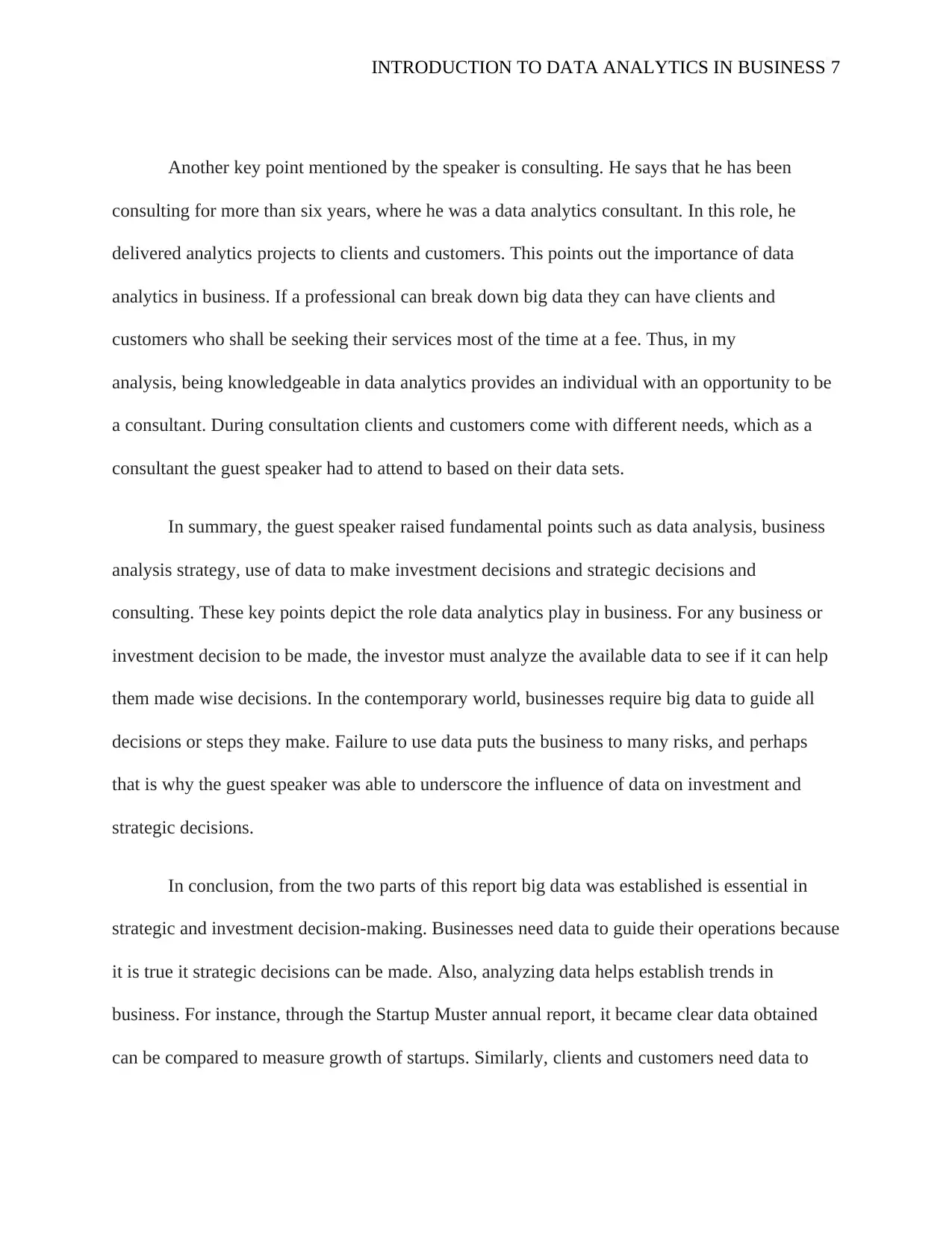
INTRODUCTION TO DATA ANALYTICS IN BUSINESS 7
Another key point mentioned by the speaker is consulting. He says that he has been
consulting for more than six years, where he was a data analytics consultant. In this role, he
delivered analytics projects to clients and customers. This points out the importance of data
analytics in business. If a professional can break down big data they can have clients and
customers who shall be seeking their services most of the time at a fee. Thus, in my
analysis, being knowledgeable in data analytics provides an individual with an opportunity to be
a consultant. During consultation clients and customers come with different needs, which as a
consultant the guest speaker had to attend to based on their data sets.
In summary, the guest speaker raised fundamental points such as data analysis, business
analysis strategy, use of data to make investment decisions and strategic decisions and
consulting. These key points depict the role data analytics play in business. For any business or
investment decision to be made, the investor must analyze the available data to see if it can help
them made wise decisions. In the contemporary world, businesses require big data to guide all
decisions or steps they make. Failure to use data puts the business to many risks, and perhaps
that is why the guest speaker was able to underscore the influence of data on investment and
strategic decisions.
In conclusion, from the two parts of this report big data was established is essential in
strategic and investment decision-making. Businesses need data to guide their operations because
it is true it strategic decisions can be made. Also, analyzing data helps establish trends in
business. For instance, through the Startup Muster annual report, it became clear data obtained
can be compared to measure growth of startups. Similarly, clients and customers need data to
Another key point mentioned by the speaker is consulting. He says that he has been
consulting for more than six years, where he was a data analytics consultant. In this role, he
delivered analytics projects to clients and customers. This points out the importance of data
analytics in business. If a professional can break down big data they can have clients and
customers who shall be seeking their services most of the time at a fee. Thus, in my
analysis, being knowledgeable in data analytics provides an individual with an opportunity to be
a consultant. During consultation clients and customers come with different needs, which as a
consultant the guest speaker had to attend to based on their data sets.
In summary, the guest speaker raised fundamental points such as data analysis, business
analysis strategy, use of data to make investment decisions and strategic decisions and
consulting. These key points depict the role data analytics play in business. For any business or
investment decision to be made, the investor must analyze the available data to see if it can help
them made wise decisions. In the contemporary world, businesses require big data to guide all
decisions or steps they make. Failure to use data puts the business to many risks, and perhaps
that is why the guest speaker was able to underscore the influence of data on investment and
strategic decisions.
In conclusion, from the two parts of this report big data was established is essential in
strategic and investment decision-making. Businesses need data to guide their operations because
it is true it strategic decisions can be made. Also, analyzing data helps establish trends in
business. For instance, through the Startup Muster annual report, it became clear data obtained
can be compared to measure growth of startups. Similarly, clients and customers need data to
Paraphrase This Document
Need a fresh take? Get an instant paraphrase of this document with our AI Paraphraser

INTRODUCTION TO DATA ANALYTICS IN BUSINESS 8
help them make appropriate decisions. Hence, this report acts as an eye opener because through
it I have able to draw insights from the application of data analytics in business.
help them make appropriate decisions. Hence, this report acts as an eye opener because through
it I have able to draw insights from the application of data analytics in business.
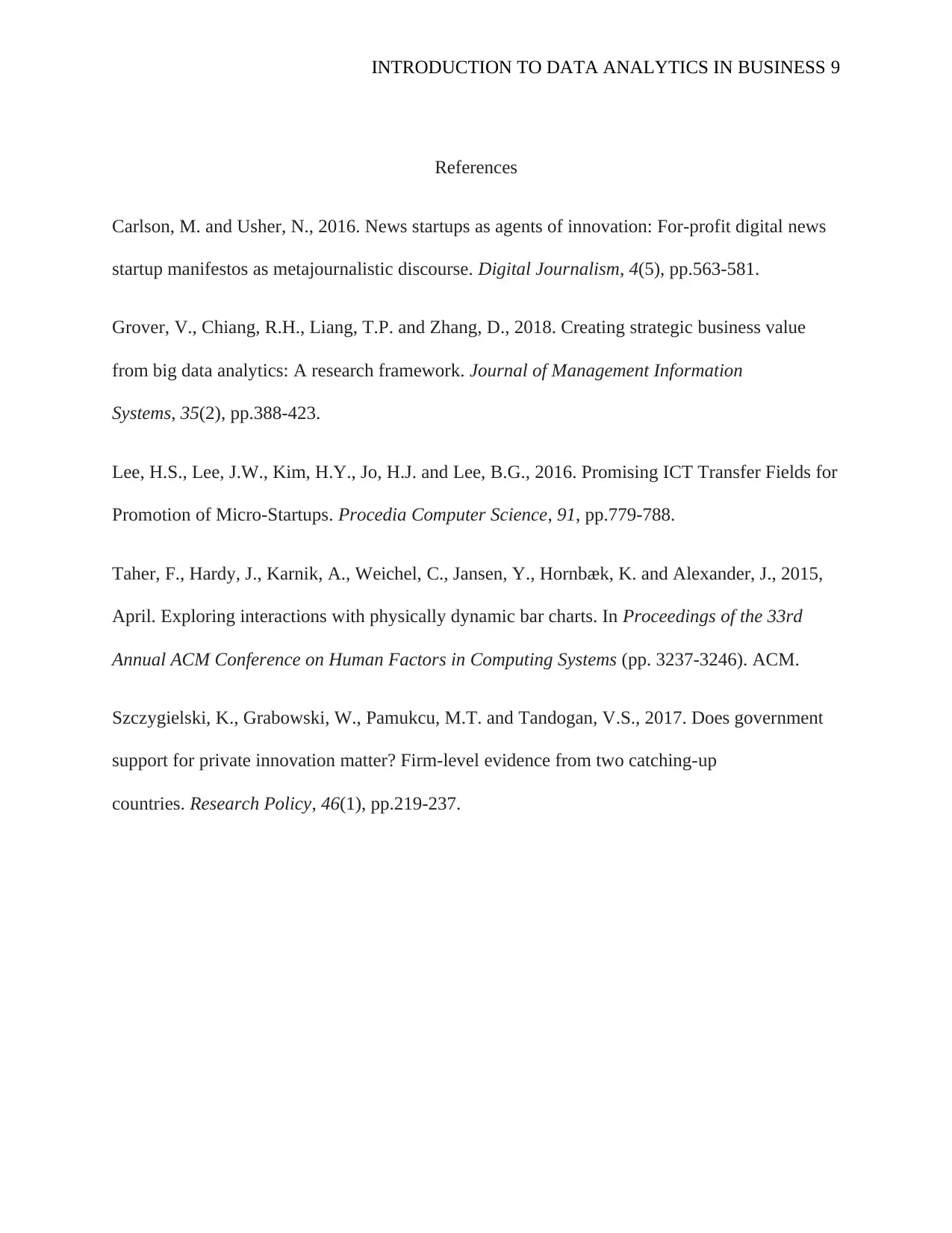
INTRODUCTION TO DATA ANALYTICS IN BUSINESS 9
References
Carlson, M. and Usher, N., 2016. News startups as agents of innovation: For-profit digital news
startup manifestos as metajournalistic discourse. Digital Journalism, 4(5), pp.563-581.
Grover, V., Chiang, R.H., Liang, T.P. and Zhang, D., 2018. Creating strategic business value
from big data analytics: A research framework. Journal of Management Information
Systems, 35(2), pp.388-423.
Lee, H.S., Lee, J.W., Kim, H.Y., Jo, H.J. and Lee, B.G., 2016. Promising ICT Transfer Fields for
Promotion of Micro-Startups. Procedia Computer Science, 91, pp.779-788.
Taher, F., Hardy, J., Karnik, A., Weichel, C., Jansen, Y., Hornbæk, K. and Alexander, J., 2015,
April. Exploring interactions with physically dynamic bar charts. In Proceedings of the 33rd
Annual ACM Conference on Human Factors in Computing Systems (pp. 3237-3246). ACM.
Szczygielski, K., Grabowski, W., Pamukcu, M.T. and Tandogan, V.S., 2017. Does government
support for private innovation matter? Firm-level evidence from two catching-up
countries. Research Policy, 46(1), pp.219-237.
References
Carlson, M. and Usher, N., 2016. News startups as agents of innovation: For-profit digital news
startup manifestos as metajournalistic discourse. Digital Journalism, 4(5), pp.563-581.
Grover, V., Chiang, R.H., Liang, T.P. and Zhang, D., 2018. Creating strategic business value
from big data analytics: A research framework. Journal of Management Information
Systems, 35(2), pp.388-423.
Lee, H.S., Lee, J.W., Kim, H.Y., Jo, H.J. and Lee, B.G., 2016. Promising ICT Transfer Fields for
Promotion of Micro-Startups. Procedia Computer Science, 91, pp.779-788.
Taher, F., Hardy, J., Karnik, A., Weichel, C., Jansen, Y., Hornbæk, K. and Alexander, J., 2015,
April. Exploring interactions with physically dynamic bar charts. In Proceedings of the 33rd
Annual ACM Conference on Human Factors in Computing Systems (pp. 3237-3246). ACM.
Szczygielski, K., Grabowski, W., Pamukcu, M.T. and Tandogan, V.S., 2017. Does government
support for private innovation matter? Firm-level evidence from two catching-up
countries. Research Policy, 46(1), pp.219-237.
⊘ This is a preview!⊘
Do you want full access?
Subscribe today to unlock all pages.

Trusted by 1+ million students worldwide

INTRODUCTION TO DATA ANALYTICS IN BUSINESS 10
1 out of 10
Your All-in-One AI-Powered Toolkit for Academic Success.
+13062052269
info@desklib.com
Available 24*7 on WhatsApp / Email
![[object Object]](/_next/static/media/star-bottom.7253800d.svg)
Unlock your academic potential
Copyright © 2020–2025 A2Z Services. All Rights Reserved. Developed and managed by ZUCOL.